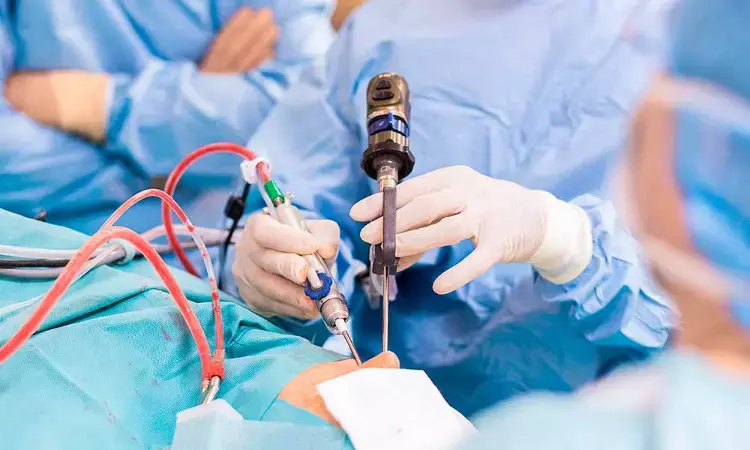- Home
- Medical news & Guidelines
- Anesthesiology
- Cardiology and CTVS
- Critical Care
- Dentistry
- Dermatology
- Diabetes and Endocrinology
- ENT
- Gastroenterology
- Medicine
- Nephrology
- Neurology
- Obstretics-Gynaecology
- Oncology
- Ophthalmology
- Orthopaedics
- Pediatrics-Neonatology
- Psychiatry
- Pulmonology
- Radiology
- Surgery
- Urology
- Laboratory Medicine
- Diet
- Nursing
- Paramedical
- Physiotherapy
- Health news
- Fact Check
- Bone Health Fact Check
- Brain Health Fact Check
- Cancer Related Fact Check
- Child Care Fact Check
- Dental and oral health fact check
- Diabetes and metabolic health fact check
- Diet and Nutrition Fact Check
- Eye and ENT Care Fact Check
- Fitness fact check
- Gut health fact check
- Heart health fact check
- Kidney health fact check
- Medical education fact check
- Men's health fact check
- Respiratory fact check
- Skin and hair care fact check
- Vaccine and Immunization fact check
- Women's health fact check
- AYUSH
- State News
- Andaman and Nicobar Islands
- Andhra Pradesh
- Arunachal Pradesh
- Assam
- Bihar
- Chandigarh
- Chattisgarh
- Dadra and Nagar Haveli
- Daman and Diu
- Delhi
- Goa
- Gujarat
- Haryana
- Himachal Pradesh
- Jammu & Kashmir
- Jharkhand
- Karnataka
- Kerala
- Ladakh
- Lakshadweep
- Madhya Pradesh
- Maharashtra
- Manipur
- Meghalaya
- Mizoram
- Nagaland
- Odisha
- Puducherry
- Punjab
- Rajasthan
- Sikkim
- Tamil Nadu
- Telangana
- Tripura
- Uttar Pradesh
- Uttrakhand
- West Bengal
- Medical Education
- Industry
Ultrasound-Guided Suprazygomatic Maxillary Nerve Block effective for Postoperative Pain in Functional Endoscopic Sinus Surgery: Study

FESS is presently the conventional surgical approach for managing sinonasal pathologies. Recent randomized controlled trial aimed to assess the efficacy of ultrasound-guided suprazygomatic maxillary nerve block (SZMNB) for postoperative pain management in patients undergoing functional endoscopic sinus surgery (FESS). The study enrolled 48 adult patients aged 18-65 years with ASA physical status I-II who were scheduled for FESS. Patients were randomly allocated to receive either SZMNB with general anesthesia (GA) (n=24) or GA alone (n=24).
Study Outcomes
The primary outcome was the numerical rating scale (NRS) pain score in the immediate postoperative period. Secondary outcomes included 24-hour postoperative rescue analgesic consumption, surgeon satisfaction score, postoperative hemodynamics, and postoperative complications.
Postoperative Pain Scores
The median (IQR) NRS pain score in the immediate postoperative period was significantly lower in the SZMNB group compared to the control group -[0 (0-0.25) vs 2 (1.75-3), p<0.001-]. Pain scores were also significantly reduced at all time points up to 24 hours after surgery in the SZMNB group compared to control (p<0.001).
Rescue Analgesia
None of the patients in the SZMNB group required rescue analgesia, whereas 8 patients in the control group required intravenous diclofenac within 1 hour of surgery and 10 patients within 1-6 hours. The time taken to perform the SZMNB block was 485 (SD 26.0) seconds. Successful spread of the local anesthetic was confirmed in 37 out of 40 blocks, and the maxillary artery was visualized in 35 out of 40 blocks.
Postoperative Parameters
Postoperative heart rate was significantly lower in the SZMNB group compared to control up to 2 hours after surgery (p<0.05), but mean arterial pressure was similar between groups. There was no significant difference in surgeon satisfaction scores or incidence of postoperative complications between groups.
Conclusion
In conclusion, the ultrasound-guided SZMNB provided excellent postoperative analgesia for patients undergoing FESS without significant side effects. This regional nerve block technique can be effectively utilized to improve postoperative pain management in patients undergoing FESS.
Key Points
Here are the 6 key points from the research paper: 1. The study was a randomized controlled trial that aimed to assess the efficacy of ultrasound-guided suprazygomatic maxillary nerve block (SZMNB) for postoperative pain management in patients undergoing functional endoscopic sinus surgery (FESS). 2. The primary outcome was the numerical rating scale (NRS) pain score in the immediate postoperative period, while secondary outcomes included 24-hour postoperative rescue analgesic consumption, surgeon satisfaction score, postoperative hemodynamics, and postoperative complications. 3. The median NRS pain score in the immediate postoperative period was significantly lower in the SZMNB group compared to the control group, and pain scores were also significantly reduced at all time points up to 24 hours after surgery in the SZMNB group. 4. None of the patients in the SZMNB group required rescue analgesia, whereas 8 patients in the control group required intravenous diclofenac within 1 hour of surgery and 10 patients within 1-6 hours. 5. Postoperative heart rate was significantly lower in the SZMNB group compared to the control group up to 2 hours after surgery, but mean arterial pressure was similar between groups. There was no significant difference in surgeon satisfaction scores or incidence of postoperative complications between groups. 6. The ultrasound-guided SZMNB provided excellent postoperative analgesia for patients undergoing FESS without significant side effects, and this regional nerve block technique can be effectively utilized to improve postoperative pain management in patients undergoing FESS.
Reference –
Neupane A, Jain D, Arora S, Gandhi K, Singla V, Goel N, et al. Evaluation of ultrasound‑guided suprazygomatic maxillary nerve block in functional endoscopic sinus surgery for postoperative pain relief: A randomised controlled trial. Indian J Anaesth 2024;68:706‑11
MBBS, MD (Anaesthesiology), FNB (Cardiac Anaesthesiology)
Dr Monish Raut is a practicing Cardiac Anesthesiologist. He completed his MBBS at Government Medical College, Nagpur, and pursued his MD in Anesthesiology at BJ Medical College, Pune. Further specializing in Cardiac Anesthesiology, Dr Raut earned his FNB in Cardiac Anesthesiology from Sir Ganga Ram Hospital, Delhi.


